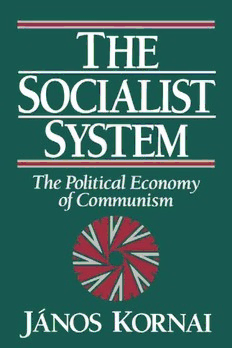
The Socialist System The Political Economy Of Communism PDF
Preview The Socialist System The Political Economy Of Communism
THE SOCIALIST SYSTEM This page intentionally left blank THE SOCIALIST SYSTEM THE POLITICAL ECONOMY OF COMMUNISM János Kornai CLARENDON PRESS OXFORD This book has been printed digitally and produced in a standard specification in order to ensure its continuing availability OXFORD UNIVERSITY PRESS Great Clarendon Street, Oxford OX2 6DP Oxford University Press is a department of the University of Oxford. It furthers the University's objective of excellence in research, scholarship, and education by publishing worldwide in Oxford New York Auckland Cape Town Dar es Salaam Hong Kong Karachi Kuala Lumpur Madrid Melbourne Mexico City Nairobi New Delhi Shanghai Taipei Toronto With offices in Argentina Austria Brazil Chile Czech Republic France Greece Guatemala Hungary Italy Japan South Korea Poland Portugal Singapore Switzerland Thailand Turkey Ukraine Vietnam Oxford is a registered trade mark of Oxford University Press in the UK and in certain other countries Published in the United States by Oxford University Press Inc., New York © János Komai, 1992 The moral rights of the author have been'asserted Database right Oxford University Press (maker) Reprinted 2007 All rights reserved. No part of this publication may be reproduced, stored in a retrieval system, or transmitted, in any form or by any means, without the prior permission in writing of Oxford University Press, or as expressly permitted by law, or under terms agreed with the appropriate reprographics rights organization. Enquiries concerning reproduction outside the scope of the above should be sent to the Rights Department, Oxford University Press, at the address above You must not circulate this book in any other binding or cover And you must impose this same condition on any acquirer ISBN 978-0-19-828776-6 For my first reader, Zsuzsa This page intentionally left blank Contents List of Figures xiii List of Tables xv Prefacee xix PART ONE: POINTS OF DEPARTURE 1. The Subject and Method 3 /. / Specific Lines of Historical Development and General Features 3 1.2 Socialist Countries 4 1.3 Interpretation of the Term "Socialism" 9 1.4 Political Economy 11 1.5 Positive Analysis 12 1.6 Models 15 1.7 Evaluation 16 2, Antecedents and Prototypes of the System 18 2.1 Marx's Image of Socialism 18 2.2 System Prototypes 19 2.3 The System before the Socialist Revolution 21 2.4 The Revolutionary Transition toward the Classical System 26 PART TWO: THE ANATOMY OF THE CLASSICAL SYSTEM 3. Power 33 3.1 The Party 33 3.2 The State 36 3.3 The Mass Organizations 39 3.4 Cohesive Forces 40 3.5 Internal Conflicts 44 3.6 Repression and the Totalitarian Nature of Power 45 4, Ideology 49 4.1 The Official Ideology 49 4.2 The Socialist System's Sense of Superiority 50 4.3 The Basic Promises 53 4.4 The Self-Legitimation and Paternalistic Nature of Power 55 4.5 Discipline, Willing Sacrifice, and Vigilance 57 4.6 Power and Ideology 59 vii viiii CONTENTS 5. Property 62 5.1 Explanation of the Concepts 62 5,2 Some Characteristic Property Forms before the Advent of the Socialist System 67 $3 The State-Owned Firm 71 5.4 Other State Property Forms 75 5.5 The Cooperative 76 5.6 Private Property and Production Activity of a Private Nature S3 5.7 Capitalism, Socialism, and Property 87 6. Coordination Mechanisms 91 6.1 Main Types 91 6.2 Some Observations on the Main Types 95 s 6.3 Bureaucratic Coordination 97 6.4 Market Coordination 100 6.5 Self-Governing Coordination 103 6.6 Ethical Coordination 105 6.7 Family Coordination 106 6.8 Spontaneous and Artificial Changes 108 7. Planning and Direct Bureaucratic Control 110 7.1 The Precursors of Socialism on the Subject of Planning 110 7.2 Initial Approach: Elaboration of the Plan 111 7.3 Initial Approach: Plan Implementation and Management t 114 7.4 The Motivation of Leaders in the Economic .Bureaucracy 118 7.5 Bargaining and Inner Conflict t 121 7.6 Planning, Management, and Politics 124 7.7 The Problem of Informationn 127 8. Money and Price 131 8.1 Banking 131 8.2 The State Budget 134 83 Survey of Money Flows 139 8.4 Soft and Hard Budget Constraint 140 8.5 Income and Price Responsiveness 145 8.6 Administrative Producer Prices 149 8.7 Administrative Consumer Prices 153 8.8 Market Prices 155 8.9 Nonprice Signals 156 9. Investment and Growth 160 9.1 Expansion Drive and Investment Hunger 160 9.2 Central Allocation and Investment Tension 163 9.3 Investment and Consumptionn 165 CONTENTS IX 9.4 Priorities 171 9.5 Extensive and Intensive Methods 180 9.6 Fluctuations in Growth; Cycles 186 9.7 Measurement of Aggregate Output 193 9.8 The System-Specific Growth Type: Forced Growth 197 9.9 Growth Performance 199 10. Employment and Wages 203 10.1 The Road to Full Employment t 204 10.2 The Development of Chronic Labor Shortage 211 10.3 Direct Bureaucratic Control of Employment and Wages 216 10.4 Employer-Employee Relations in the Factory 218 10.5 Bureaucratic and Market Influences on Wages 224 11. Shortage and Inflation: The Phenomena 228 11.1 Shortage Phenomena and the Shortage Economy 229 11.2 The Process of Demand Adjustment t 234 11.3 Horizontal and Vertical Shortage 240 11.4 Shortage and Surplus 243 11.5 Market Regimes: The Buyers' and the Sellers' Market 245 11.6 Normal Shortage and Normal Surplus 252 1L7 Open, Declared, and Hidden Inflation 255 12. Shortage and Inflation; The Causes 262 12.1 The Behavior of the Firm: Short-Term Decisions 262 12.2 The Behavior of the Firm: Long-Term Decisions 268 12.3 The Behavior of the Bureaucracy Managing Production 270 12.4 Relative Prices 273 12.5 Repressed Inflation in Interfirm Relations 275 12.6 Repressed Inflation in the Consumer Sphere 278 12.7 Excess Demand on the Macro Level 280 12.8 The Propensity to Inflation; the Relationship between Shortage and Inflation 283 12.9 The Self-Inducement and Reproduction of Shortage 286 12.10 The System-Specific Nature of the Causes 288 12.11 Economic Efficiency and Technical Progress 292 13. Consumption and Distribution 302 13.1 The Growth of Consumption 302 13.2 Other Factors in Material Welfare 304 e 13.3 Economic Security 311 13.4 First Approach: Distribution of Money Income 316 13.5 The Distribution of Material Welfare: Other Manifestations 318
